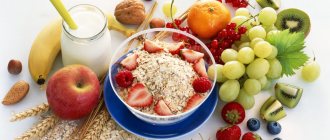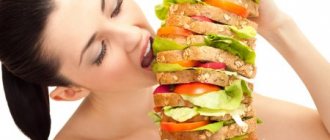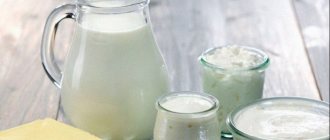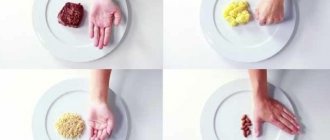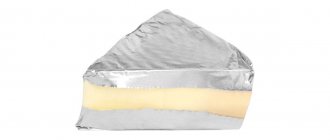One of the main methods of treatment and prevention of acetone syndrome (the presence of a large number of ketone bodies in the blood) is diet. It is aimed at restoring metabolism in the body.
Treatment and diet for acetone in children, Komarovsky E.O. believes they should start simultaneously. Treatment with medications will not have the desired effect if the patient continues to consume prohibited foods. This method, according to the doctor, will contribute to the child’s recovery.
Causes of acetonemia in children
With ketoacidosis, a child's metabolic processes in the body are disrupted. The disease occurs due to an increased amount of ketone bodies in the baby’s urine and blood. If there is little glucose in his body (which should come from slow carbohydrates), then energy is taken from fats. And the consumption of the latter causes protein depletion. As a result of fat processing, ketone bodies are formed.
The main symptoms of acetonemia are vomiting, fever and diarrhea. The disease is necessarily characterized by a pronounced smell of acetone from the baby’s urine and vomit. The odor may also come from the child's body.
You can determine the level of acetone in the urine of children at home. To do this, use special tests (litmus strips that change color). Place the strip in your child's test container. Then apply the litmus strip to the special color scale. Subsequent descriptions of the instructions will indicate how the resulting color characterizes the level of acetone in the urine.
The main causes of ketoacidosis in a child:
- Unbalanced or unhealthy diet.
- Frequent hysterical behavior and prolonged crying.
- Too much physical activity for the child.
- Infectious diseases that are accompanied by fever.
If early signs and symptoms of the disease appear, you should immediately consult an experienced doctor. He will prescribe a strict diet that will help get rid of ketone bodies in the baby’s blood and urine.
ads
When should you worry?
Let's find out in what cases treatment is urgently required, as well as a diet for acetone in children.
The table reflects the indicators identified using a litmus strip.
| Index | 0.5 to 1.5 mmol/l (+) | 2-5 mmol/l (++) | more than 5 mmol/l (+++) |
| Danger level | Easy stage. The child should be given more to drink and not given fatty foods. | Middle stage. The child requires a light diet. Avoid fatty and spicy foods. Give glucose and alkaline drinks. | Difficult stage. You should consult a doctor. A strict diet is required. |
Nutritional Features
The main requirements for the diet for acetonemia:
- All food is cooked in water, without adding sugar or salt.
- The child is allowed to consume only natural products, without dyes, preservatives and all kinds of flavor enhancers. Preference is given to low-fat foods and dishes.
- Drink plenty of fluids. Along with water, you can consume milk, dried fruit compote, and kefir in small quantities.
- The diet must include cereal porridge (corn, buckwheat) cooked in water.
- During the diet, fresh fruits and vegetables should be limited and consumed, but infrequently. Baked apples are allowed to be eaten.
- Don't let your baby feel hungry for a long time.
But if the child does not want to eat at all, do not force him. If food causes a gag reflex, especially do not offer it to your child. When he wants to eat something, you can give him some unsweetened homemade crackers.
Prevention
To help the young body cope with the harmful effects. It is necessary to take care of the proper organization of your lifestyle. A number of recommendations will help with this.
- Maintaining a healthy lifestyle. In this case, daily walks, outdoor games and moderate physical activity are useful. No less important are hygienic and health procedures - taking baths, rubbing with cool water and others.
- Good food. Children's diets must include cereals, milk products, vegetables and fruits.
- Sleep quality. A well-slept and rested body works at full strength, which reduces the risk of acetone accumulation.
- Prevention of the development of infections. Timely vaccination and strengthening the immune system with vitamins and minerals. Annual blood and urine tests, ultrasound examination of internal organs.
All of the above preventive measures are prescribed not only for children with acetone syndrome, but also for healthy children, because taking care of the immune system always comes first.
What can a child eat?
Parents should know what foods are allowed to feed their son or daughter. With the right approach, you can make your baby’s diet balanced and rich in essential microelements and vitamins. What can a baby eat with elevated acetone:
- lean meats: turkey, rabbit;
- fermented milk products with low fat content - always fresh, milk;
- vegetables (zucchini, carrots, pumpkin, potatoes), boil or bake them; over time, you can give fresh carrots in small quantities;
- chicken eggs (no more than 1 per day);
- some freshly squeezed juices;
- from sweets - a small amount of honey, jam.
At the onset of the disease, the diet should be free of any meat and fresh vegetables. After relief, you can gradually introduce these foods into your diet. When the level of ketone bodies decreases, you can expand the child’s diet.
Etiology
The most common cause of severe ketoacidosis is type 1 diabetes mellitus.
Diabetic ketoacidosis occurs due to an absolute or relative deficiency of insulin that develops over several hours or days. I.
In patients with newly diagnosed insulin-dependent diabetes mellitus, partial or complete deficiency of endogenous insulin is caused by the death of beta cells of the pancreatic islets.
II.
In patients receiving insulin injections, the causes of ketoacidosis may be: 1. inadequate therapy (prescription of too small doses of insulin);
2. violation of the insulin therapy regimen (skipped injections, expired insulin); 3. a sharp increase in the need for insulin in patients with insulin-dependent diabetes mellitus: a) infectious diseases: sepsis (or urosepsis); pneumonia; other upper respiratory and urinary tract infections; meningitis; sinusitis; periodontitis; cholecystitis, pancreatitis; paraproctitis. b) concomitant endocrine disorders: thyrotoxicosis, Cushing's syndrome, acromegaly, pheochromocytoma; c) myocardial infarction, stroke; d) injuries and/or surgical interventions; e) drug therapy: glucocorticoids, estrogens (including hormonal contraceptives); f) pregnancy; g) stress, especially in adolescence. In all of the above cases, the increase in the need for insulin is due to increased secretion of counter-insular hormones - adrenaline (norepinephrine), cortisol, glucagon, growth hormone, as well as insulin resistance - a decrease in tissue sensitivity to the action of insulin. III.
In a quarter of patients, the cause of diabetic ketoacidosis cannot be determined.
What drinking regime should you follow?
The main key to successful treatment, in addition to diet, is maintaining the correct drinking regime. In addition to water, give your baby drinks that contain a lot of fructose (and therefore glucose). Give your baby some dried fruit compote. This drink can increase blood glucose levels. The infusion should be warm, slightly sweetened with honey.
Raisins also contain a lot of fructose. You can not just give your child dried grapes, but an infusion from them. To do this, pour a small handful of raisins with a glass of boiling water, cover and leave for 15 minutes. Strain the infusion through cheesecloth and give it to your child.
To prevent a sharp increase in acetone, always give your baby sugary drinks after stress or increased physical activity, as well as during illness.
Give your child warm, sweetened tea. Do not add sugar, but use its substitute - fructose. It breaks down in the body faster and does not provoke a sharp jump in blood glucose levels.
The main rules to follow when drinking:
- all drinks must be warm. This will allow them to be absorbed easier and faster;
- let's drink little and often (about 10 ml every 10-15 minutes);
- The total amount of glucose consumed per day should be approximately 5 mg per 1 kg of weight, and drinking fluid - 120 ml per 1 kg of the child’s weight.
Lemon and honey will help fight high acetone
As has long been known, these two products can not only improve weakened immunity, strengthen the walls of blood vessels, and resist toxins, but also help fight acetone. Honey and lemon contain a huge amount of vitamins, microelements, and most importantly, glucose and fructose. These products are absorbed well and quickly enough by the body, which gives it the opportunity to quickly return to normal.

If your baby is not prone to allergic reactions, then prepare him a delicious drink. Take a liter of boiled warm water, 40 g of natural honey and juice squeezed from half a lemon. Mix well and let your child drink in small portions. The baby should finish the entire drink during the day. Prepare fresh in the morning.
Prohibited Products
Diet with acetone should exclude:
- Products with dyes, flavor enhancers, food additives. These are sausages, chips, crackers, mayonnaise, ketchup, smoked meats.
- All fatty fish and meats, as well as lard.
- Mushrooms and dishes made from them.
- Sour fruits and vegetables. Eliminate oranges, kiwi, spinach, sorrel, radishes, eggplants, and tomatoes from the menu.
- Pastries (cakes, pastries, cookies) and chocolate.
- Legumes: lentils, peas, beans.
- Fatty dairy and fermented milk products, hard cheese.
- Fats (both animal and vegetable), fish oil.
Diet for acetone syndrome in children
Avoid prohibited foods until your baby is fully recovered. His meals should be fractional, 5-6 times a day. Don't take long breaks between meals. It's good if steamed vegetables are included in every meal.
Only an experienced doctor can prepare an approximate diet for a child. The diet is approved and adjusted by a specialist. Introduce new products gradually, monitor the body's response.
Try to make your baby's menu as varied as possible. Give him the opportunity to love his diet. After all, the baby will have to eat this way for about 2-3 months.
Children's menu options for acetone in urine
Menu option No. 1
- Breakfast - thin oatmeal with a handful of mixed nuts and dried fruits, fruit tea.
- Lunch – baked apple and a glass of low-fat yogurt.
- Lunch – stewed vegetables, veal meatballs, dried fruit compote.
- Afternoon snack – boiled egg, cucumber.
- Dinner – cauliflower soup.
Menu option No. 2
- Breakfast - rice porridge with milk, tea with croutons.
- Lunch – two pears.
- Lunch – vegetable soup, boiled chicken breast, raisin infusion.
- Afternoon snack – fruit jelly.
- Dinner – steamed fish cutlets, boiled buckwheat porridge, a glass of compote.
Menu option No. 3
- Breakfast - boiled egg, salad of baked beets, grated, with the addition of walnuts and raisins, green tea with biscuits.
- Lunch – low-fat cottage cheese with berries.
- Lunch – rabbit soufflé, boiled potatoes, cabbage and herb salad, fruit jelly.
- Afternoon snack – a glass of kefir, a sweet apple.
- Dinner – pureed pumpkin soup with croutons, compote.
Menu option No. 4
- Breakfast – corn porridge with milk, a couple of baked apples, compote.
- Lunch – fruit salad with yogurt.
- Lunch – vegetable soup with pearl barley, chicken meatballs, tea, 2 pcs. marshmallows
- Afternoon snack – semolina porridge with a spoonful of jam.
- Dinner – Venigret salad, a glass of sour milk.
Menu option No. 5
- Breakfast - buckwheat porridge, boiled egg, cabbage and cucumber salad, tea with croutons.
- Lunch – berry jelly.
- Lunch – stewed cabbage, mashed potatoes, rabbit soufflé, compote.
- Afternoon snack – cottage cheese balls with berry syrup.
- Dinner – baked pollock fillet with steamed vegetables, compote.
By adhering to this diet and simple rules of eating and drinking, you will help your baby quickly get rid of increased acetone, as well as prevent the possible development of many ailments of the gastrointestinal tract.
Tokareva Larisa, pediatrician
27, total, today
( 179 votes, average: 4.64 out of 5)
Mascarpone cheese - benefits and harms
Horseradish: benefits and harm
Related Posts
What medications can you use?
You should have glucose ampoules on hand. If a child complains of dizziness or vomiting, give him a 40% concentrated glucose solution.
A normal percentage of alkali in the body is also the key to a quick recovery. Let your baby drink mineral water without gas, and in addition, the drugs “Regidron” or “BioGaia Ors”, which are aimed at restoring the acid-base balance. Get Nicotinamide tablets - they will help glucose be absorbed faster.
Along with sweet drinks, you can additionally give your baby a solution or tablet of vitamin PP. Be sure to consult your pediatrician before purchasing medications.
Treatment
Infusion therapy is first aid for severe ketoacidosis
Ketosis
Therapeutic tactics boil down to eliminating the causes that provoked ketosis, limiting fat in the diet, and prescribing alkaline drinks (alkaline mineral waters, soda solutions). It is recommended to take methionine, essentiale, enterosorbents, enterodesis (at the rate of 5 g, dissolve in 100 ml of boiled water, drink 1-2 times). If, after the above measures, ketosis is not eliminated, an additional injection of short-acting insulin is prescribed (on the recommendation of a doctor!). If the patient used insulin in one injection per day, it is advisable to switch to an intensive insulin therapy regimen. They recommend cocarboxylase (intramuscular), splenin (intramuscular) for a course of 7...10 days. It is advisable to prescribe alkaline cleansing enemas. If ketosis does not cause any particular inconvenience, hospitalization is not necessary - if possible, carry out the listed activities at home under the supervision of specialists.
Ketoacidosis
With severe ketosis and symptoms of progressive decompensation of diabetes mellitus, the patient requires hospital treatment. Along with the above measures, the insulin dose is adjusted in accordance with the glycemic level, switching to administering only short-acting insulin (4...6 injections per day) subcutaneously or intramuscularly. intravenous drip infusions of isotonic sodium chloride solution (saline) are performed, taking into account the age and condition of the patient.
Patients with severe forms of diabetic ketoacidosis, stages of precoma, are treated according to the principle of diabetic coma.
